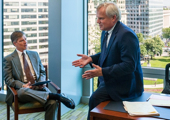Doug Wendt is a co-founder and senior partner with Wendt Partners.
 In developing a business growth strategy, every CEO needs to see the workplace as a strategic asset. Creating and fostering the right work culture may involve reconfiguration of current space, offering co-working opportunities, anticipating rapid entry into new markets or supporting a distributed workforce. We sat down with Angie O'Grady, president of Carr Workplaces, to discuss important workplace considerations for CEOs as they plan for growth.
In developing a business growth strategy, every CEO needs to see the workplace as a strategic asset. Creating and fostering the right work culture may involve reconfiguration of current space, offering co-working opportunities, anticipating rapid entry into new markets or supporting a distributed workforce. We sat down with Angie O'Grady, president of Carr Workplaces, to discuss important workplace considerations for CEOs as they plan for growth. WP: There was a time when 'workplace strategy' consisted of taking a company from the startup phase in a garage or basement, directly to a traditional space with offices and cubicles. Is that era now over?
AO: I have spent the last 28 years in the executive suite/business center industry. 28 years ago, our clients wanted to create the impression that the entire shared space was actually their office. Fast forward to today – being in a shared office space is seen as being part of a supportive professional community, and is viewed as a smart business decision. As a business leader, an executive suite offers you a lot of flexibility as your company grows and your needs change.
You don’t have to commit to space, infrastructure or staff members, and thus expenses, that you might not need a few months down the line. If your company does grow and you need larger space of your own, we offer WorkReady Suites. These privately accessed spaces offer access to the Carr Workplaces services and community that all of our clients enjoy.
Thankfully, more and more companies are aware that our product exists and that it offers significant advantages over traditional leased space. The whole concept of sharing has become an accepted way to drive a car (Zipcar), select a place to stay (Air BnB), etc. Carr Workplaces is truly a part of the sharing economy.
WP: Your company was formed predominantly around the executive suite or serviced offices model. How is that model changing to meet shifts in workplace expectations?
AO: As with all businesses, we have to be nimble with our product offering to meet the needs of the market. We are continually introducing new products and tweaking our center design to ensure that our workplaces appeal to the workforce of today. Technology has created an enormous shift in the way people work. We are introducing new technology solutions to make it quick and easy for both prospects and clients access the spaces, services and support they need.
We’ve also seen an increased value placed on community. We’re tying our client community and events into these technology solutions to allow clients to connect and work together, even if they’re physically located in different places. This all comes from to the two biggest things we’ve heard from our clients – their most precious resource is time, and they want to be part of a professional community as long as it adds value to their day.
WP: More and more companies are considering coworking, open office design and flexible working for their workforce. Do you think these trends will integrate with, or rather replace, traditional officing?
AO: I don’t think these new workplace designs will replace traditional officing. Not all people and all positions are productive working in an open plan or co-working environment. I believe that there is a blend for some organizations. For others, perhaps one design works best for their team. It is important for all business leaders to understand what is important to their team members and where possible, offer options to allow a team member to be the most productive.
Each of our spaces has certain brand standards, but they also have different features and personalities. It’s not just the space that matters, but also the community of people working there. With all of the traditional, shared office and co-working options on the market today, it’s really important for business leaders to understand what they’re getting.
Decision makers should really consider their priorities, whether they be flexibility, privacy, community, support, permanence, or professionalism, and they should look for a solution that embraces the elements that are most vital to their organization.
WP: When (if ever) do you think most companies should opt for traditional office leases?
AO: Never! Hah…. A couple of different scenarios come to mind in which the CEO should seriously consider a traditional lease as the best option:
- If you have a good handle on your space needs for the next 5-10 years and expect them to remain essentially constant during that timeframe.
- If it is important that you have your own space from a company culture perspective.
- If due to the constraints of a government contract or complex client requirement, you need extra security that most executive suite and co-working environments cannot provide for you.
Even in these cases, you might want to consider using shared spaces for meetings, training sessions and corporate events.
We also have many companies use our space while they are waiting for the build-out of their traditional office. And, we have enterprise clients that are headquartered in a traditional office, but use our products to help them develop a presence in new markets without making a large upfront investment. Furthermore, we have also accommodated some pretty unique compliance needs - for example, hosting an embassy within one of our centers.
WP: Your company now offers a co-working solution, a move-in-ready dedicated office option (WorkReady Suites), and nearly half of the space at your newest facility is for flexible working options. What does this suggest about the future of work?
AO: I think this suggests that the way people want to work is changing and that these changes will continue into the future. We are developing new products to allow our clients to work the way they want to work. The future of work is all about flexibility, and using smart technology and space to allow your business to thrive.WP: A lot of the discussion around workplace strategy emphasizes culture and community within teams, across companies and between businesses as well. How does a company like Carr Workplaces support this priority, both in the design and operation of centers?
AO: Community has always been a priority at Carr Workplaces. Many of our clients are small companies with one to three employees. In terms of space design, we always have a community café area in our centers, which facilitates conversation and collaboration over morning coffee or lunch.
We host events in our centers aimed at helping clients enrich their networks. Our staff actively tries to connect clients with one another if they think there may be synergies. We will be launching a new client portal in the near future that will provide our clients with an opportunity to network across centers, and with a way to market their services to our entire client network.
WP: As a nationwide company, are you seeing the same trends in both space design and workplace culture, being embraced in New York, Los Angeles, Chicago, Miami and Atlanta?
AO: Yes, we are seeing consistency throughout the U.S. in terms of space design and workplace culture trends. We find that many of our clients, no matter their market, face the same challenges and have similar goals. In the past, there was a missed opportunity for knowledge transfer. While we’ve always had strong communities at the local level, we believe we can help our clients even more if we connect them with similar companies using our space in other markets.WP: Many experts emphasize the value of open office design in attracting and retaining millennial workers. Do you believe that the design and structure of the office environment is an essential ingredient in building this new workforce?
AO: I don’t believe that one space type fits all workers. While, yes, the millennial workers do thrive on collaboration, depending on the individual and the job they are performing, open office design might not always be the answer.
Again, I think you need to understand your team and the tasks at hand. It goes back to prioritization of needs. If someone needs to be on the phone all day long, or works better in a really quiet environment with few distractions, they are going to perform at a higher level in a private office, no matter their generation.
Millennials are embracing flexibility and choice in the workplace – they want to work in a manner that best suits their personal tastes.
WP: It's not uncommon for business owners to perceive anything other than a traditional lease as overly expensive. What are the costs that most CEOs forget to include when comparing traditional vs. serviced space?
AO: The beauty of the shared office model is that you have access to the services that you need and for the most part, you only pay for them when you use them. When evaluating our spaces, many people forget to factor in the cost of a team member to answer phones and/or act as a receptionist, and as a client of ours, you have access to various sizes of conference rooms, event spaces and day offices across our network.
When you are building out your own space, you have to dedicate square footage to a conference room, which is typically used infrequently. There are also the costs of the copier (which again – our copier is probably much nicer with more features than the models most companies would put in their own space); the telephone system; the furniture; the coffee machine (and coffee); the binding machine; the kitchen; the reception area… the list goes on.
A traditional lease often looks reasonable until you factor in the cost of all of these priorities, and then once you do, the approach we offer suddenly comes into focus as a highly efficient, cost-effective solution.
WP: What are some key pieces of advice you'd encourage every CEO to keep in mind when planning for the future of their company's workspace strategy?
AO: My first piece of advice would be to do your research – understand your team and understand all of the various workspaces that are available. Keep an open mind on the space options. For example: Just because you don’t want to work in an open space, doesn’t mean your team won’t think an open space is best.
Second, I believe that workspace strategy will continue to evolve, so think about how to give yourself flexibility and options as your business grows and changes.
Third, do a full cost-benefit analysis of your space options. You may find that a higher fixed monthly rate actually saves you in build-out, staffing, infrastructure, operations and other costs.
And finally, remember that the objective of your space design and strategy ties back to the culture of your company, and this takes careful planning and commitment over time. A community is not made - it grows. How you select, configure and manage your workspace is a powerful factor in the overall success of that growth.
 Image Credit: Carr Workplaces
Image Credit: Carr Workplaces







